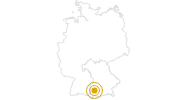Contents
Route description
Germany’s Allgäu region has been attracting hikers with its fresh, new trilogy of long-distance hiking routes since the summer of 2014. In addition to the Wiesengänger route (“Meadow walker”), hikers can also explore the region with the Wasserläufer (“Water runner”) and Himmelsstürmer (“Heaven hotspur”) routes.
The trilogy is supported by 33 partner towns, each of which are designated as either portal, stage or themed towns. All these towns offer hikers a starting point providing substantial information on the route ahead. These starting points are easy to spot, marked as they are with the symbol of the hiking trilogy – a little stone man. The portal towns are strongly linked to the overarching theme of each trilogy area and the Allgäu in general. Themed towns away from the routes are also great destinations to spend some time and gain some insights into the local area. The individual stages start and end – as the name suggests – in the so-called stage towns. These often offer additional attractions complementing the respective theme of each trilogy area.
Gentle hills
The Wiesengänger route leads through the northern Allgäu over the gentle hills and terraced landscape around Bad Wörishofen, Marktoberdorf and Leutkirch. As a result, this route is dominated by easy walking, with walks passing drumlins (hills formed by glaciers), marshes and old glacial drift. In total, the route encompasses some 388 kilometres and 23 stages. As the route is designed to be circular, you can choose to start in numerous different towns or just walk individual stages as a day hike.
In harmony with body and soul
The Wiesengänger’s portal towns include Bad Wörishofen, Bad Wurzach and Isny. Bad Wörishofen is the former stomping ground of the priest Sebastian Kneipp and a place central to his philosophy of harmonising body and soul. The so-called “Glückswege”(happiness trails) start here, leading walkers through an immersive landscape where healing waters, plants and herbs abound. The stage town for these “Glückswege” is Bad Grönenbach, where Sebastian Kneipp acquired his knowledge and discovered his passion for plants.
Black gold
Bad Wurzach tells the story of the Allgäu’s “Naturschutzkammern” – a unique boggy landscape with extraordinary flora. The Wurzacher Ried is a must for all visitors, being as it is the largest intact high bog area in Central Europe. Visitors can get more information from the “Moor extrem” exhibition in the conservation centre there. In addition to these beautiful landscapes, the stage town of Kißlegg and portal town of Bad Wurzach also boast stunnings baroque structures which culture lovers will love.
Free towns
The third themed area on the Wiesengänger route is “Heimatstätte”. Isny is the central hub in this area, a town which has been able to preserve many of its medieval structures. The individual stages leads through the towns of Wangen, Leutkirch and Altusried. Isny, Wangen and Leutkirch were previously free imperial cities in which citizens could trade free of any authority from a king or higher rule. The beautiful marketplaces, old town walls and winding streets are still worth exploring today. In contrast, Altusried is a town more synonymous with cultural freedom – a place known for its lively theatre culture and 135-year-old open-air stage.
Visitors can enjoy guided routes focusing on the story of each themed area in both the portal and stage towns. Interesting themed towns away from the route are also worth exploring. Plenty of information is always provided along the routes, revealing special stories about the places along the way or pointing out sights of outstanding natural beauty.
Where to eat
There are plenty of places to grab a drink or some food on the route. In terms of accommodation, walkers are spoilt for choice with 49 partner hotels to choose from – a range which includes everything from wellness hotels to family-run B&Bs. All of these accommodation options fulfil high quality criteria and are certified with the seal of quality “Wanderbares Deutschland” among other standards.
Interesting facts
- With an overall length of 388 km the hike is currently the longest hike in Germany available on TouriSpo.
- Hiking boots are not required, but the hike might be more enjoyable with sturdy footwear (especially in wet conditions). If you get hungry along the way, there are places to rest and get food. Nevertheless it’s recommended to also have enough water and food in your backpack when hiking or biking.
Highlights of the tour
The Wiesengänger route is suitable for walkers who prefer leisurely paths with relatively few hills. Nature lovers will love the “Glückswege” section with its expansive views and fascinating boggy landscape. On the other hand, culture lovers will be fascinated by the route passing through the former free towns.
Variations
Themed towns are not located directly on the routes themselves. They are not connected to each respective hiking trail, but are instead intended to provide a specific unique insight into Allgäu for visitors. Wiesengänger hikers can make a detour to visit the basilica in Ottobeuren, Mindelheim with its historic old town, or Kaufbeuren, known for its Crescentia cloister.
Getting here
By car:
If you’re heading to Allgäu by car, take either the A7 from Ulm to Füssen or the A96 from Munich and Lindau.
By public transport:
Oberstdorf and Lindau are served by the Allgäu Express (ALEX) rail service which starts in Munich. The Bavarian railway service (Bahnland Bayern) then connects the individual towns in the region.
If you are travelling by plane, book a ticket to Allgäu-Airport Memmingen or fly to Friedrichshafen, Munich or Stuttgart.





